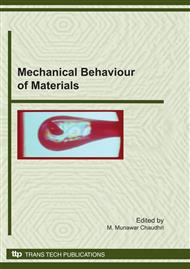[1]
A.D. Roberts and D. Tabor : Proc. Roy. Soc. Lond. Vol. A325 (1971) pp.323-345.
Google Scholar
[2]
A.D. Roberts : Eng. Mater. Design Vol. 12 (1969) pp.55-59.
Google Scholar
[3]
R. Stribeck: Z. Ver. dt. Ing. Vol. 46 (1902) p.1341; 1432-1463.
Google Scholar
[4]
A.D. Roberts : Eng. Mater. Design Vol. 11 (1968) 579-580.
Google Scholar
[5]
H. Hertz : Miscellaneous papers. Macmillan, London, UK (1896) p.146.
Google Scholar
[6]
K.L. Johnson, K. Kendall and A.D. Roberts : Proc. Roy. Soc. Lond. Vol A324 (1971) pp.301-313.
Google Scholar
[7]
D. Tabor: J. Colloid Interface Sci. Vol. 58 (1977) pp.2-13.
Google Scholar
[8]
A.D. Roberts and A.G. Thomas : Wear Vol. 33 (1975) pp.45-64.
Google Scholar
[9]
A.N. Gent and J. Schultz: Proc. Int. Rubber Conf. Brighton, IRI, London (1972) Paper C1.
Google Scholar
[10]
A.D. Roberts : Rubb. Chem. Technol. Vol. 52 (1979) pp.23-42.
Google Scholar
[11]
D. Maugis and M. Barquins : J. Phys. D: Appl. Phys. Vol. 11 (1978) p.1989-(2023).
Google Scholar
[12]
J.A. Greenwood and K.L. Johnson: Phil. Mag. Vol. A43 (1981) pp.697-711.
Google Scholar
[13]
R.A. Schapery: Int. Fract Vol. 11 (1975) pp.549-562.
Google Scholar
[14]
G. Haiat, M.C. Phan Huy and E. Barthel:J. Mech. Phys. Sol. Vol. 51(2003) pp.69-99.
Google Scholar
[15]
J.A. Greenwood : J. Phys. D: Appl. Phys. Vol. 37 (2004) pp.2557-2569.
Google Scholar
[16]
J.A. Greenwood and K.L. Johnson: J. Coll. Interface Sci. Vol. 296 (2006) pp.284-291.
Google Scholar
[17]
K.L. Johnson : Microstructure and Microtribology of Polymer Surfaces Ed.K.J. Wahl and V.V. Tsukruk (Amer. Chem. Soc., USA 2000).
Google Scholar
[18]
E. Bartel: Journal of Physics D: Applied Physics Vol. 41 (2008) 163001.
Google Scholar
[19]
A.D. Roberts : J. Phys. D: Appl. Phys. Vol. 4 (1971) pp.423-432.
Google Scholar
[20]
E.J.W. Verwey and J.T.G. Overbeek: Theory of stability of lyophobic colloids (Elsevier, Amsterdam 1948).
Google Scholar
[21]
B.V. Derjaguin and L. Laundau: Acta Physiochem. USSR Vol. 14 (1941) pp.633-662.
Google Scholar
[22]
A.D. Roberts: J. Coll. Interface Sci. Vol. 41 (1972) pp.23-34.
Google Scholar
[23]
J.N. Israelachvili: Intermolecular and Surface Forces (Academic Press, 2nd Edition, London, UK 1992).
Google Scholar
[24]
P.A. Lewis: Direct measurement of the forces of interaction between macroscopic bodies (Ph.D. Thesis, Bristol University, UK 1972).
Google Scholar
[25]
D.B. Hough and R.H. Ottewill: Progr. Colloid&Polymer Sci. Vol. 68 (1983) pp.101-112.
Google Scholar
[26]
S.C. Richards, A.D. Roberts and P. Barnes: J. Nat. Rubber Res. Vol. 10 (1995) pp.154-169.
Google Scholar
[27]
A.D. Roberts: J. Phys. D: Appl. Phys. Vol. 4 (1971) pp.433-440.
Google Scholar
[28]
T.P. Mortimer and K.C. Ludema: Wear Vol. 28(1974) pp.197-206.
Google Scholar
[29]
L. Sokoloff and S.L. Lee: Wear Vol. 88(1983) pp.207-219.
Google Scholar
[30]
S.C. Richards and A.D. Roberts: J. Nat. Rubber Res. Vol. 9 (1994) pp.190-204.
Google Scholar
[31]
S.F. Chen and A.D. Roberts: 3 (1998) pp.167-176.
Google Scholar
[32]
A.D. Roberts and J.C. Richardson: Wear Vol. 67 (1981) pp.55-69.
Google Scholar
[33]
K. Kendall: Molecular adhesion and its applications (Kluwer Academic, New York, USA 2001).
Google Scholar
[34]
D. Maugis: Contact, Adhesion and Rupture of Elastic Solids (Springer, Berlin, Germany 2000).
Google Scholar
[35]
D.E. Packham: Int.J. Adhesion and Adhesives Vol16 (1996) pp.121-128.
Google Scholar
[36]
D.C. Prieve and S.G. Bike: Chem. Eng. Communications Vol. 55 (1987) pp.149-164.
Google Scholar
[37]
S. Bai, P. Huang, Y. Meng and S. Wen: Tribology Int. Vol. 39 (2006) pp.1405-1412.
Google Scholar
[38]
M. Kalin, S. Novak and J. Vizintin: J. Phys. D: Appl. Phys. Vol. 39 (2006) pp.3138-3149.
Google Scholar
[39]
Pawlak, J. Kotynska, Z.A. Figaszewski, A. Oloyede, A. Gadomski and A. Gudaniec: J. Achievements Mater. Manufacturing Engineering Vol. 23 (2007) pp.47-50.
Google Scholar
[40]
D.B. Hough and R.H. Ottewill: Colloid and Interface Science IV Ed M. Kerker (Academic Press, New York, USA 1976).
Google Scholar


